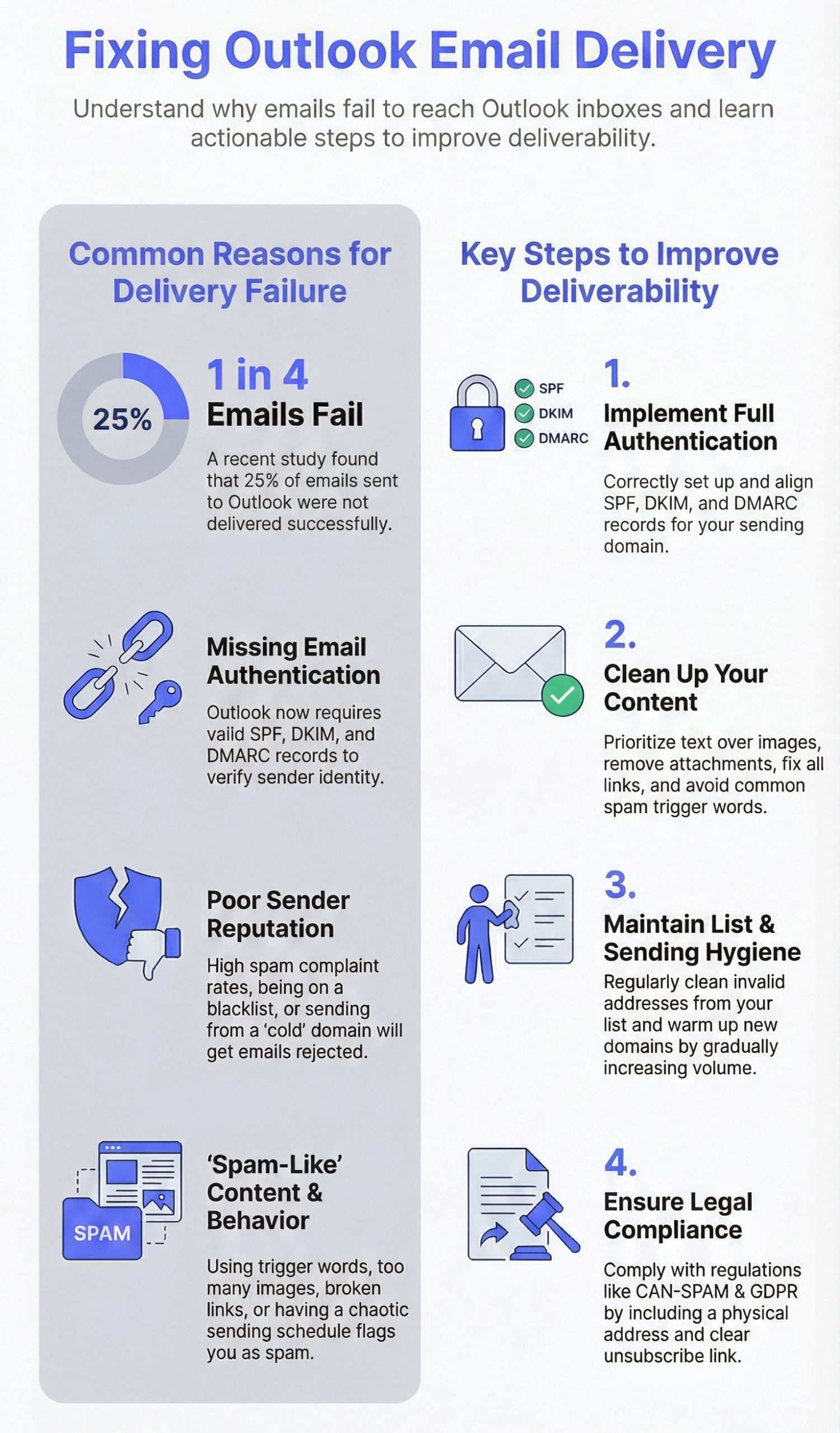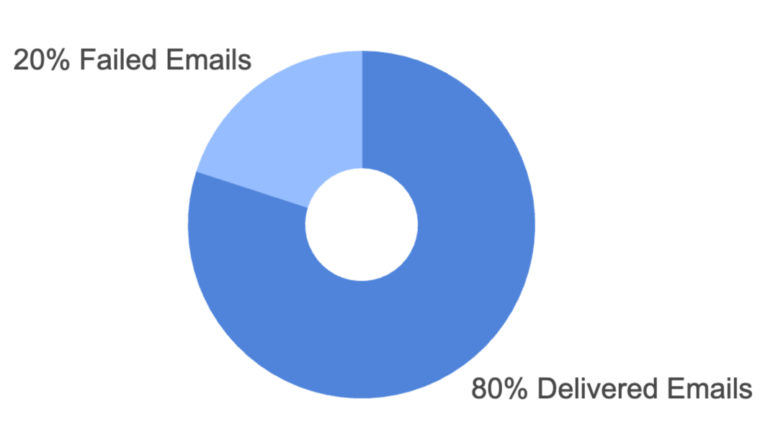Did you know that over 400 million people use Outlook? According to recent studies, Microsoft’s long-standing email reader currently holds almost 4.5% of the market share, occupying the third spot in the list of the most popular email providers worldwide.
This is largely due to its integration with the Microsoft Office Suite, which makes it one of the most preferred solutions among businesses, entrepreneurs, and Microsoft users. However, despite its pretty position, it is infamous for its slow adaptation to modern technologies, regular inconsistencies in email display, and deliverability issues.
Chances are, your subscription list might contain Microsoft users. So, you cannot ignore your Outlook email delivery problems. Whether you operate in the B2B or B2C sector, fixing those delivery issues is crucial to secure your email efforts. Here is how you can do that.
Popular Reasons for Email Delivery Problems at Outlook

Although Outlook is one of the most popular email service providers worldwide, second only to Apple Mail and Gmail, it is not nearly as flawless as the top two. It has incompatibility issues, a lack of proper support even for the most time-proven HTML and CSS features, and regular delivery problems.
Consider the research conducted by Unspam. Their team has found that every fourth message sent by their clients was not delivered to Outlook, unlike Google, which has handled nine out of ten messages successfully.
Nevertheless, that does not mean you should ignore it, as many people use it as their trusted communication tool. Fixing Outlook email delivery problems and ensuring uninterrupted conversation with your subscribers is crucial. To do so, start by understanding why these problems occur.
So, the first reason you experience email delivery failures is that your email server is poorly configured or lacks authentication. Authentication has turned from an option to a necessity for those companies that want to communicate with their Outlook subscribers.
Early in 2025, Microsoft enforced several security-related standards for senders, especially those sending large volumes of email. Today, complete, valid, and relevant implementation of SPF, DKIM, and DMARC protocols is required. Therefore, if you miss some of these correctly configured records, your digital correspondence might be rejected.
Another security-related update introduced by Microsoft early this year could cause another delivery problem. The industry giant started seriously considering spam and spam complaint rates, asking companies to maintain them as low as possible, meeting industry benchmarks. Therefore, high spam complaints or constantly triggered spam filters might easily halt your outreach.
The second reason why companies might experience email delivery problems with Outlook is issues with the user’s side. Many details might ruin your email campaign, starting with a full mailbox and ending with specific settings that might put your messages in the spam folder by default.
Just as your subscribers’ email ecosystem might have issues, the same can happen to your side. Therefore, the third reason for poor delivery is a technical problem with your server or the infrastructure setup on your end. Even the most reliable systems crash, have technical glitches or experience downtime, so your environment might cause not just delays but also prevent you from sending your email in the first place.
Finally, blacklisting. Like all popular ESPs and ISPs, Outlook is adamant about blacklisted IP addresses and domains. It rejects them right away, leaving no room for maneuver.

How to Fix Email Delivery Problems at Outlook?
Here are the most popular email delivery problems with Outlook and their corresponding solutions.
Use Unspam to Determine the Problem
Numerous situations lead to poor email delivery at Outlook, from glitches in your technical infrastructure to users’ full mailboxes. Whatever the reason for poor email outreach, it is crucial to identify it correctly. The surefire way to do this is to use a professional instrument to inspect your email from various angles and surface problems, inconsistencies, and faux pas.
For that, you need Unspam, one of the leading instruments in the niche that scans your email and locates issues. It is a fully-fledged, feature-rich professional platform that unites an email spam-checking system with a deliverability test machine. It has everything you need to locate all sorts of problems.
For instance, it thoroughly inspects SPF, DKIM, DMARC, list-unsubscribe header, Domain suffix and age, email content, design, and even blacklist vendors, leaving no stone unturned. The best part is that it provides a report in a convenient form so you can quickly and efficiently interpret results and devise a plan for eliminating issues.
There is more; you might also take advantage of their expert email deliverability consultants who specialize in enhancing inbox placement across various platforms, not only Outlook. They will help you eliminate all the barriers that ruin your outreach.

Authentication Problems
Authentication problems are among the most common reasons for poor email delivery. While several years ago, it was a mere recommendation, today, it is a requirement enforced by many email providers, including Outlook. Introducing SPF, DKIM, and DMARC safety protocols in digital correspondence has become mandatory for senders, even when their daily volumes are less than 5,000 emails.
Therefore, start with authenticating your emails. This routine implies introducing safety measures according to three main protocols: SPF, DKIM, and DMARC. Simply put, you must set up email authentication records for your sender’s domain, create corresponding DNS records, and place them on your server.
However, what if you have authenticated emails? In that case, it is crucial to determine whether everything works correctly and surface the issue by checking your email in Unspam. Here are some popular scenarios:
If the SPF record fails, ensure it includes all your legitimate email sources, does not exceed 10 DNS lookups, and the Return-Path address used during email delivery matches your domain.
If the DKIM record fails, do the following checks:
- Ensure the public key is relevant and valid. If it is incorrect, generate a new one.
- Ensure the public key is published correctly.
- Verify the email’s signature against the public key.
If the DMARC fails, take these steps:
- Ensure the DKIM signature is set up correctly.
- Permit third-party services involved in email communication with subscribers, like marketing platforms, to send emails on your domain’s behalf.
- Ensure SPF and domain alignment.
- Verify DKIM digital signature.
- Ensure your DMARC policy is correctly configured. If in doubt, always start with a p=none policy.
Last, it would also help monitor your DMARC records, as they might surface hidden issues with specific emails. Since these reports are provided in an XML format, it is advisable to use professional instruments to transform them into user-friendly data.
Technical Issues
While you cannot do much about your technical environment unless you are an expert in server configuration and troubleshooting, you must still determine the problem correctly and ask the support team to address it in time.
Even the best of us might encounter technical problems. Google, Microsoft, and popular ISPs regularly experience temporary issues or downtime. Therefore, scan your infrastructure to determine if it works as intended.
The most popular problems with the part that sends the emails are:
- The misconfigured SMTP server.
- The SMTP server connection is malfunctioning.
- Outdated setup.
- Downtime due to high traffic or network issues.
- No security protocols like SSL or TLS are in place.
Conduct an audit of the existing ecosystem. Narrow down the problem and address it with the help of the ISP support team.
However, there are some problems with your technical environment that you can sort out on your own. This primarily concerns IP or a domain with a poor reputation. Only your behavior and email marketing strategy might solve this.
For instance, you might change your IP address from a shared one to a dedicated one. Although it might cause additional expenses, it is the only way to ensure you stay clean. As for a domain’s poor reputation, you might initiate a warming-up routine or devise a strategy that proves ESPs the legitimacy and trustworthiness of your connection.
User’s Issues
Problems with your infrastructure and the technical side of email communication seem like child’s play compared to issues caused by the recipient’s side. These could be incorrect mailbox settings, a full inbox, issues with the recipient’s server or email platform, server downtime, or Outlook personal configurations.
The sad truth is you cannot solve them, as your subscribers must handle them. However, you can still do something. If you suspect the problem is on the other side, it is highly recommended to do the following:
- Contact the recipient and pinpoint the problem.
- Ask your subscribers to check their email settings.
- Ask your subscribers to whitelist your contact address.
- Consult with the user’s email service provider to investigate and resolve the server issues.
- Ask for explicit permission from the recipient before sending them any emails. This especially concerns organizations that enforce email quarantine policies.
- Wait and send your message once again.
Spammy-like Behavior
No one likes spammers, and Outlook is no exception. As malicious actors become more sophisticated, ESPs are getting picky and intolerant of senders whose behavior might look suspicious. Here are the most popular spammer-like behaviors that are better to eliminate:
You hit your daily sending limit. Solution: Know your industry benchmark; for instance, Microsoft allows 5,000. Set your limits and never exceed them depending on your ESP or ISP.
You use spam words in the subject line or body copy. Solution: Double-check your email content to eliminate phrases that trigger email spam filters.
Your email is unreadable and inaccessible. Solution: Introduce an information hierarchy and format your content according to standards. Use headings, spacing, and proper typeface, ensure optimal contrast, and add alt text to images.
Your email has more graphics than text. Solution: Remove images and prioritize text since many Outlook versions do not accept image-based emails.
Your message includes an attachment or a script. Solution: Remove all attachments and scripts as they are unwelcome and, most of the time, unsupported by Outlook.
Your message has broken links, shortened URLs, and incorrectly declared CTAs. Solution: Check your content against all those faux pas and fix all inconsistencies.
You have a chaotic sending routine. Solution: Create a plan based on an email marketing strategy and enforce outreach regularly.
You send a large number of messages from a cold domain or email address. Solution: Warm up your domain and email with fewer messages and gradually increase your volume.
Last but not least, poor engagement. This might happen often at Outlook, as the email provider is infamous for incorrectly displaying brand messages. This inconsistency in message delivery easily pushes away even the most loyal subscribers, making the company look unprofessional. Solution: Understand all the nuances of Outlook handling email content and design. Always test and preview the newsletter and surface issues that might cause display discrepancies. Use professional email template builders like Postcards that do all the heavy lifting for you.
Compliance with Laws and Regulations
One of the most non-obvious and unexpected problems that causes delivery problems is failing to meet laws and regulations established in the email environment, like the CAN-SPAM Act and GDPR. Much like authentication, compliance is non-negotiable and mandatory for every business operating in the channel, regardless of its sending volume. To fix this issue, you need to undertake several important steps.
First, check your email in Unspam for possible inconsistencies. The platform will provide you with a comprehensive report that can help you determine the root of the problem.
Second, thoroughly inspect the relevant documentation provided by regulatory bodies. Ensure you understand all the demands, requirements, and nuances for your country, industry, and market segment. It is also highly advisable to monitor official websites for updates to make necessary adjustments and stay relevant and compliant with the laws.
Third, ensure you meet these criteria:
- The header information is relevant and valid.
- Your subject line is not pushy, deceptive, or misleading.
- You clearly define the purpose of the message, especially with the commercial intention.
- Your body copy does not include spam words, baits, or misleading information.
- You feature your physical address and the means to contact you directly through phone or post.
- Every email contains an unsubscribe button, which provides an easy and quick way to opt out of your subscription list.
- You do not bother subscribers who have asked to have their contact information removed from your list.
Finally, monitor what others are doing on your behalf. Whatever company you partner with to assist you in email marketing, you are responsible for their actions. Therefore, ensure they also follow the laws.
Last but not least, an Invalid Email Address
As banal as it may sound, invalid email addresses are among the most common reasons for poor email deliverability. This could be due to a user’s sign-up error or incorrect insertion on your side. Therefore, it is crucial to double-check everything and clean and validate your subscription list regularly.
So, if you receive the bounce rate, follow this simple routine:
In case of a soft bounce rate, try to send it once again, as it could be a technical communication problem, like server downtime or the user’s full inbox.
In case of a hard bounce, either update the contact address with the correct one or remove it from your list.
Conclusion
Although Outlook remains one of the most popular email clients, it is not a perfect platform. It may raise many obstacles to correct and successful outreach. The main email delivery problems are authentication failures, low sender scores, technical mistakes, incorrect user settings, spam-like behavior, blacklisting, and poor engagement.
Fixing email delivery problems at Outlook requires several crucial steps. First, determine the problem by testing your email in Unspam and checking error logs. Second, eliminate the root causes. Third, check your email before sending it. Finally, stick to the best practices in the niche and avoid looking like a spammer.





